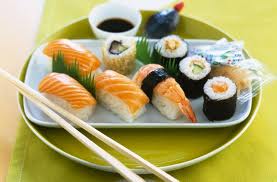Eating Sushi Erev Pesach
|
We begin our interaction with Gd and Life, with the premise that everything is permitted, other than that which is specifically prohibited.
Our Sages take a very dim view of those who look for unnecessary stringencies and seek to reduce the enjoyment of those things that Gd created for us to enjoy. |
I have indicated that the Halacha permits consumption of Kitniyos all day Erev Pesach, just as we may consume potatoes all day Erev Pesach.
Rabbi K - I have removed his name as he has since removed his article from the public arena - has offered his learned opinion in response, and I thank him for contributing to this discussion. Rabbi K writes that, “for Ashkenasim, Kitniyos are as stringent as Chamets” and may therefore not be consumed on Erev Pesach in the same way and during the same times that Chamets is prohibited. Now, this is clearly an exaggeration. You see, unlike Chamets, we may keep Kitniyos in our home during Pesach. The RaMa is the master of Minhag Ashkenaz and the source for our Minhag of not consuming Kitniyos during Pesach, Shulchan Aruch OCh 453:1. RaMa declares without reservation that unlike Chamets, Kitniyos need not be sold. In fact Kitniyos may be kept in our “Pesach kitchen”. So, although the Minhag of Kitniyos is driven by concerns that it can be easily confused with Chamets, as Rabbi K explained, it is nevertheless also clear in and from the Halacha that this Minhag did not ever suggest that Kitniyos ought to be handled and categorised as Chamets. So it is misguided and illogical to suggest that Kitniyos are prohibited on Erev Pesach in the same way and at the same times that Chamets is prohibited because, “for Ashkenasim, Kitniyos are as stringent as Chamets”. Here is another important difference between Kitniyos and Chamets. Chamets which becomes inadvertently mixed into Pesach food BEFORE Pesach, will be deemed insignificant at our standard Halachic proportion of 1 to 60. This is not true however with regard to Kitniyos inadvertently mixed into Pesach food [even if this occurs DURING Pesach] Kitniyos are deemed to be insignificant as long as they are less than half of the volume of the mixture. So, even though one can easily discern the taste and flavour of the rice flour in the Pesach Cholent, it is Kosher and may be eaten by Ashkenasi Jews during Pesach. [Mishneh Berurah 453:9] Clearly, it is not true to say that “for Ashkenasim, Kitniyos are as stringent as Chamets” BTW, according to the Halacha we have just discussed, we may eat regular non KLP chocolate that contains lecithin, and drink regular non KLP juices and lemonades that use Kitniyos sweeteners, since these contain Kitniyos that are less than 50% of the mixture and the Kitniyos are not readily identifiable to the unaided eye. Foods containing 49% Kitniyos, that are not specifically manufactured for Jews to consume during Pesach, have the same status as foods that are specifically manufactured for Jews to consume during Pesach into which 49% Kitniyos were inadvertently mixed. It is worthwhile explaining at this point that the guidelines that shape the prohibition of eating Kitniyos during Pesach are not determined by the Laws of Kashrus. Thus when Kitniyos becomes inadvertently mixed into our foods we do not use the usual Kosher ratio of 1 part to 60. The reason being that this custom has its own set of guidelines which are determined by the Minhag itself, as explained by the Mishneh Berurah 453:8. Again we see the extraordinary qualities of leniency ascribed to Kitniyos that do not apply to Chamets. Clearly, it is not true to say that “for Ashkenasim, Kitniyos are as stringent as Chamets” Rabbi K also seeks proof from Siman 444. We must eat three meals every Shabbos. This is also true when Erev Pesach occurs on Shabbos. However, on Erev Pesach we may not eat a bread meal after late morning. Must the third meal comprise bread and be eaten in the morning, or is “meat or fruit” adequate which can be consumed in the afternoon? See Shulchan Aruch OCh 444. The Shulchan Aruch does not provide a comprehensive “Kosher List” of acceptable foods for the Third Meal for Shabbos, but offers classifications – Bread, Category 1; Meat, Category 2; and Fruit, Category 3. [Mishneh Berruah 444:8] There is no interest at this point nor any need to elaborate these categories as they are self-evident. Kitniyos are clearly less significant than meat. [apologies to my vegetarian friends] Suggesting that a proof can be fashioned from the Shulchan Aruch’s omission of Kitniyos as an acceptable option for a Shabbos meal, is not a sensible observation nor a credible argument. Rabbi K also quotes a number of Acharonim. For the time being I will not comment on these, other than saying that to the best of my knowledge they do not offer any proofs to support their suggestions. BTW, suggesting that something which is not explicitly permitted in the Shulchan Aruch must be prohibited, is not a credible argument unless it is a case clearly dexcribed in the Gemara that is omitted. |



